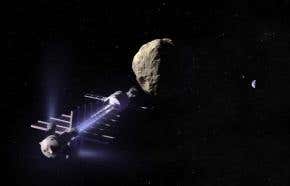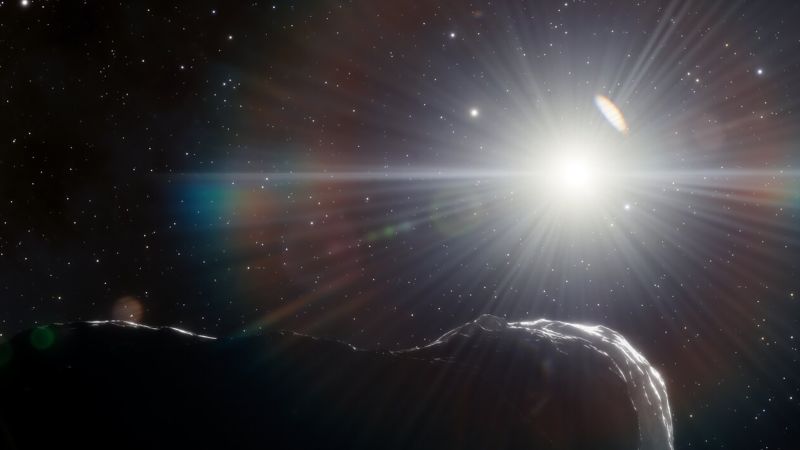This. Since we don't have detailed data on what the target is like it's impossible to accurately model what will happen. We need to shoot (both kinetic and nuclear) at various targets and see what sort of results we actually get. (The only other proposal for which the nature of the target matters is blowing it apart with a high-yield bomb in it's core.)Actually, it was also very much about momentum. The amount of deflection of the asteroid isn't just due to the momentum transferred from the spacecraft, but also due to the equal and opposite reaction to the force that blasted debris from the impact crater into space. NASA will be studying the new orbit to calculate how much material was thrown out of the crater and how fast it escaped. The recoil is a significant factor in how effective this deflection method is, and it had to be determined by experiment, not just calculated from Newtonian mechanics.
-
Features
-
Friends of IIDBFriends Recovering from Religion United Coalition of Reason Infidel Guy
Forums Council of Ex-Muslims Rational Skepticism
Social Networks Internet Infidels Facebook Page IIDB Facebook Group
The Archives IIDB Archive Secular Café Archive
You are using an out of date browser. It may not display this or other websites correctly.
You should upgrade or use an alternative browser.
You should upgrade or use an alternative browser.
Asteroid Intercept
- Thread starter steve_bank
- Start date
Jimmy Higgins
Contributor
- Joined
- Jan 31, 2001
- Messages
- 50,464
- Basic Beliefs
- Calvinistic Atheist
But how do we get it alongside the object? That sounds like a lot of energy would be needed in the probe.Why is this even in consideration?If you wanted to pulverize a large asteroid it might take multiple atomic bombs drilled into ateroid expaloding simualteneously.
Conventional explosives might work. That would probably require humans on the asteroid.
There is an idea to keep a probe at a combatant distance form the asteroid. Use gravitational attraction.

'Gravity tractor' could deflect asteroids
A gravity tractor would fly near an asteroid and gravitationally nudge it off course (Illustration: Dan Durda/FIAAA/B612 Foundation) A "gravity tractor" could deflect an Earth-threatening asteroid if it was deployed when the asteroid was more than one orbit away from the potential impact...www.newscientist.com
The only thing a gravity tractor does is allow you to pull the target without landing on it--it doesn't matter if it's a pile of dust, it will still move. However, it requires more thrust than it would take if the engine simply landed on the asteroid and does nothing to provide such thrust. It also has the problem that the thrust has to be applied off-axis because on-axis means your rocket hits the target and wastes much of your thrust--in an extreme case it could actually push the asteroid the other way.
Yes, a tractor requires rendezvous which itself is only viable for NEOs that are going to hit on a future orbit. Then your acceleration is limited to how much thrust you can apply to the tractor without simply pushing it away from the asteroid. It's not a practical system short of some sort of torch drive that can be throttled to a whisper.But how do we get it alongside the object? That sounds like a lot of energy would be needed in the probe.Why is this even in consideration?If you wanted to pulverize a large asteroid it might take multiple atomic bombs drilled into ateroid expaloding simualteneously.
Conventional explosives might work. That would probably require humans on the asteroid.
There is an idea to keep a probe at a combatant distance form the asteroid. Use gravitational attraction.

'Gravity tractor' could deflect asteroids
A gravity tractor would fly near an asteroid and gravitationally nudge it off course (Illustration: Dan Durda/FIAAA/B612 Foundation) A "gravity tractor" could deflect an Earth-threatening asteroid if it was deployed when the asteroid was more than one orbit away from the potential impact...www.newscientist.com
The only thing a gravity tractor does is allow you to pull the target without landing on it--it doesn't matter if it's a pile of dust, it will still move. However, it requires more thrust than it would take if the engine simply landed on the asteroid and does nothing to provide such thrust. It also has the problem that the thrust has to be applied off-axis because on-axis means your rocket hits the target and wastes much of your thrust--in an extreme case it could actually push the asteroid the other way.
Against comets you're going to have to do it with a flyby and that means kinetic impactor or Orion.
steve_bank
Diabetic retinopathy and poor eyesight. Typos ...
There is a possibility of an asteroid heading for Earth to get missed.

 www.cnn.com
www.cnn.com

'Planet killer' asteroid spotted hiding in the sun's glare | CNN
Astronomers have spotted three near-Earth asteroids that were lurking undetected within the glare of the sun. One of the asteroids is the largest potentially hazardous object to Earth to be discovered in the last eight years.
CNN —
Astronomers have spotted three near-Earth asteroids that were lurking undetected within the glare of the sun. One of the asteroids is the largest potentially hazardous object posing a risk to Earth to be discovered in the last eight years.
The asteroids belong to a group found within the orbits of Earth and Venus, but they’re incredibly difficult to observe because the brightness of the sun shields them from telescope observations.
To avoid the sun’s glare, astronomers leaped at the chance to conduct their observations during the brief window of twilight. An international team spied the space rocks while using the Dark Energy Camera located on the Víctor M. Blanco 4-meter Telescope located at the Cerro Tololo Inter-American Observatory in Chile.
“Our twilight survey is scouring the area within the orbits of Earth and Venus for asteroids,” said lead study author Scott S. Sheppard, an astronomer at the Earth & Planets Laboratory of the Carnegie Institution for Science in Washington, DC, in a statement.
“So far we have found two large near-Earth asteroids that are about 1 kilometer across, a size that we call planet killers.”
Scientists determined that the asteroid crosses Earth’s orbit, but it occurs when Earth is on the opposite side of the sun – this pattern will continue for centuries since it takes the asteroid five years to complete an orbit around the sun. But over time, the asteroid’s orbital movement will be more in sync with Earth’s. Scientists don’t know the asteroid’s orbit with enough precision to say how dangerous it could become in the future, but for now, it “will stay well away from Earth,” Sheppard said.
Shadowy Man
Contributor
I remember attending a talk many years ago in which it was stated that the greatest risk comes from those earth crossing asteroids with orbits mostly interior to the earth’s because they may remain undetected until possibly too late.
lpetrich
Contributor
Hera probe is tested in a vacuum chamber - March 8, 2024 - "ESA specialists placed the Hera spacecraft in a vacuum chamber located at the ESTEC test center in the Netherlands. It will spend the next three weeks in it, exposed to the same temperature influences as in real flight conditions."
 Hera (space mission) - the spacecraft has visible-light and infrared cameras and an infrared lidar system. It will release two cubesats, each with its own instruments.
Hera (space mission) - the spacecraft has visible-light and infrared cameras and an infrared lidar system. It will release two cubesats, each with its own instruments.
Hera is to be launched in October 2024 by a Falcon 9 rocket[2] which will lift off from Cape Canaveral and conduct a deep-space maneuver by November.[7] Following a gravitational assist at Mars in March 2025 where Hera will spend some time observing the Martian Moon Deimos,[8] the spacecraft will reach the binary asteroid (65803) Didymos on 28 December 2026, four years after DART, to begin six months of investigation. Hera will be the first to make a rendezvous with a binary asteroid.
